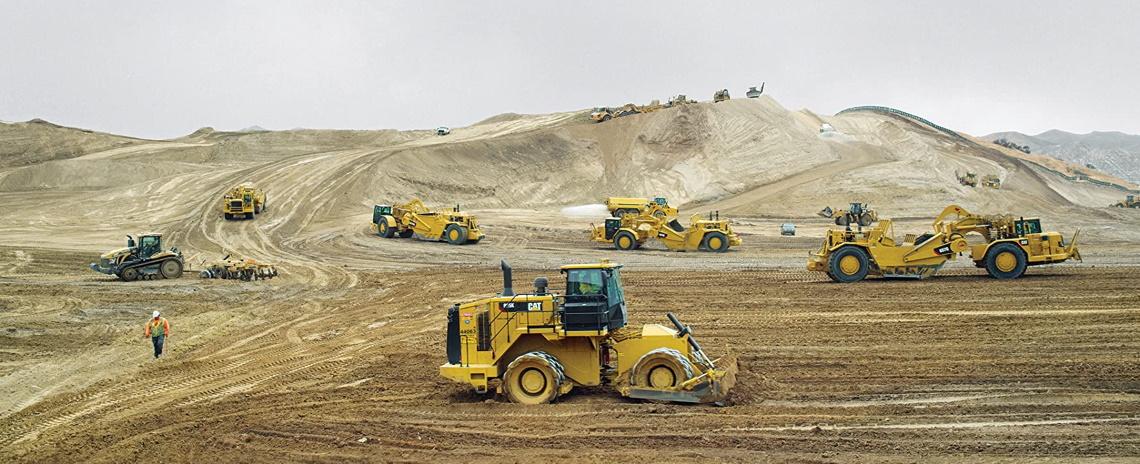“The Earth is definitely a cruel mistress,” opines one of the interviewees in the hypnotic and urgent new documentary Earth. He’s one of many subjects in the film tasked with bulldozing ground for consumerist ends: building new bustling suburbs, burying nuclear waste, or mining marble. The California laborer is referring to the – according to him – necessary work he does and the ways the planet pushes back at him. Digging tons of rock and clay is a dangerous and taxing endeavor, and in this case it’s all for the sake of a more easily navigable business district that will be built on the site in the years to come.
The question posed in Nikolaus Geyrhalter’s film is whether that work is necessary. By the feature’s end, the director makes clear that human consumption has ravaged our species’ natural habitats. The need for goods has exponentially outpaced the possibility of an industrialization that is gentler with the ground beneath our feet or on the ecosystems that are indispensable for our survival. As the film’s opening title card points out, people are now responsible for moving earthen materials at three times the rate such displacements naturally occur, inferring that humankind is now the most significant geological influence on the planet.
Geyrhalter, a veteran documentarian who’s been making films since 1972, gently prods his subjects in their workplace settings across California, Canada, Italy, Austria, Spain, and Germany. He frames them in still shots and lets them speak freely about their work – engineers, scientists, laborers, site managers, among them – before moving them into more philosophical territory with variations of a simple question: Is this right? Their responses vary from disappointingly oblivious (like the aforementioned Californian), to “somebody has to do it” pragmatism, and even to outright despair.
An Italian marble miner who claims to love his work – even though he feels it’s capable of destroying his body – has great regret for ravaging the mountainous landscape. He is acutely aware of the impact his work has on the planet: “If we keep going this fast, there won’t be any material left in 300 years. The world will change dramatically, and the children of our children will have to find something else. Or maybe we’ll be on Mars or on the moon and we’ll find new materials there. Who knows?”
If these interviews in Earth occasionally carry whiffs of on-the-nose sanctimoniousness, it’s wholly forgivable as an urgent document. However, the true miracle of Geyrhalter’s film lies in its alternating these sections with entrancing images of destruction. Establishing still aerial drone shots dwarf people in their decimated work sites like a kid’s ant-colony display laid horizontally. On the ground, Geyrhalter often mounts the camera on equipment doing its work, emphasizing the alien nature of it. These scenes occasionally recall the work of the Harvard Sensory Ethnography Lab and Lucien Castaing-Taylor and Véréna Paravel’s marvel Leviathan (2012), in which the filmmakers planted numerous Go-Pro cameras on a fishing boat, resulting in a mesmeric collage of oceanic wonders. The images in Earth are more bound than those in Leviathan but are similarly riveting. Looking down the output of a tiller as rock and mud shoot toward the mounted camera while the ground appears to rock back-and-forth is as compelling as it is ugly and disheartening.
In the penultimate section of Earth, a trip to German salt mines deep underground, Geyrhalter pulls his best cinematic trick to illuminate the mistakes of the recent past. A projector sits in the mine where barrelled toxic waste has been dumped for decades, and the original instructional propaganda short about the process is shown on its surface. However, the ultimate uppercut in a film of escalating blows brings the Big Ideas to a human scale by focusing on First Nations environmentalist Jean L’Hommecourt in her home of Fort McKay in Alberta, Canada. Ravaged by pollution, the river her people used to fish in has been deemed toxic, the animals within now inedible. She narrates a drive in her truck, expressing the sadness with which she views the land where she once hunted and played. In an act of great empathy, Geyrhalter frames not her face, but her point of view through the windshield. The highway she drives down is buttressed by forest and blue skies, a gentle reminder of humankind’s colossal footprint and a wakeup call to consumers regarding their impact, not just on the Earth but on each other.
Rating: B
Earth is available to rent from KimStim from Apr. 17 - 30. A portion of the rental proceeds will go directly to the Webster University Film Series.


